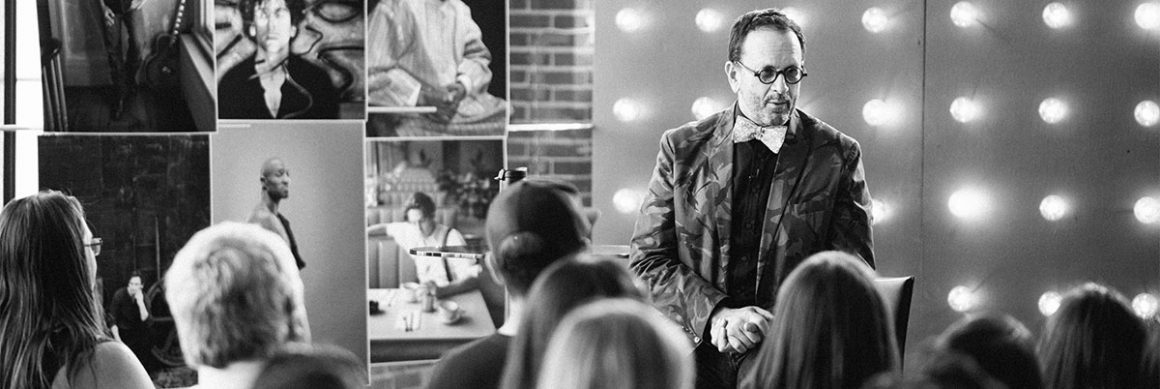
You know Gregory Heisler, or at the very least, you’ve seen his work. Gregory is a prolific photographer best known for his 70 cover portraits for TIME Magazine and has graced the pages of Life, Esquire, Fortune, GQ, Sports Illustrated, ESPN, and The New York Times Magazine.
We recently had the pleasure of hosting Gregory in our CreativeLive studios to present his talk on embracing one’s own uniqueness. Now, I attend a lot of keynotes, speeches, and presentations. Not often do I stand in the audience yelling “PREACH!” like I was during Gregory’s presentation. His thoughts on prioritizing the expression of your own voice, vision and style over technique is spot on and follows the career path of so many professional and prolific creators in my circle.
A few topics from this episode:
- Making what you can’t help but make is how you find your own unique style and it helps you get paid for your art. It’ll be easy because you can’t help but make it anyways, it’ll be your best work because it’s what comes naturally to you, and people will hire you to make more of what you can’t help but make anyways
- The three main components of making art are vision, technique, and style. Too many of us get hung up on the technique, but vision and style is what differentiates you from the rest of the pack. Lean into your own vision and develop confidence in your style.
- If you want to be a professional creative, you’ve got to get comfortable being uncomfortable. Making art is an uncertain path and there will be days where you may not be able to pay the rent or even make a good photograph, but trust and own the process.
Enjoy!
The more identifiable your voice is, the more people will hire you for that voice.
FOLLOW GREGORY:
instagram | twitter | website
Listen to the Podcast
Subscribe




Watch the Episode
Greg shows some of work in during his talk that’s worth seeing. If you want to see the video version, you can watch this talk for free here on CreativeLive.com.
In This Episode, You Will Learn:
- Why photography is the new literacy. [6:45]
- Why acknowledging, developing, and revealing your uniqueness is the only job security you can have as a photographer or artist. [7:41]
- How John Loengard helped Gregory decide “who to be like” by offering the advice to “shoot what you can’t help but shoot”. [8:30]
- Photographers used to be hired based on qualification, but now they are hired for their vision. [14:11]
- Why you shouldn’t dilute your vision. [15:00]
- The three main components of making art are vision, technique, and style. [17:00]
- For great inspiration on what executing great vision in photography, check out the documentary photographers like Sebastiao Salgado, James Nachtwey, Alex Webb, Lynsey Addario, and Henri Cartier-Bresson. [18:30]
- Technique is like a recipe. Different people could come up with a relatively similar result given the same technique. [18:50]
- Check out Arnold Newman for an example of uniqueness. [21:30]
- Irving Penn and Dan Winters are great examples of how to take one’s own vision and style across different subjects. They do it because they have enough confidence in their own style. [22:26]
- It’s ok if you don’t have a passion. Say yes to everything and make things along the way until you do. [25:00]
- The difference between the mindsets between analog and digital photography. [27:10]
- Why you need to draw inspiration from outside of your industry. [28:30]
- Check out the documentary, Visions of Light, about cinematographers in the 80s who all referenced the history of cinematography [32:20]
- Check out the book, The Nature of Photographs for a photography book that doesn’t mention light. [36:40]
- The beauty of shooting RAW. [39:00]
- Why you need to get comfortable with getting uncomfortable. [46:55]
- Don’t buy gear just because somebody else uses it. Discover your preferences by doing work and then trust your process. [48:30]
- The story behind Gregory’s photo of Mick Jagger and Tina Turner. “Just one frame.” [51:00]
- Question from the audience: “How do you stay unique while trying to capture a vision for a client?” [58:37]
- Question from the audience: “How do you present your work to clients in different industries?” [63:10]
- To get hired for a job, pitch your work that’s at least one level higher in difficulty and quality than the job you’re getting paid for. [64:13]
- Why you need to make personal work and why potential clients will love you for it. [65:00]
This podcast is brought to you by CreativeLive. CreativeLive is the world’s largest hub for online creative education in photo/video, art/design, music/audio, craft/maker, money/life and the ability to make a living in any of those disciplines. They are high quality, highly curated classes taught by the world’s top experts — Pulitzer, Oscar, Grammy Award winners, New York Times best selling authors and the best entrepreneurs of our times.



















